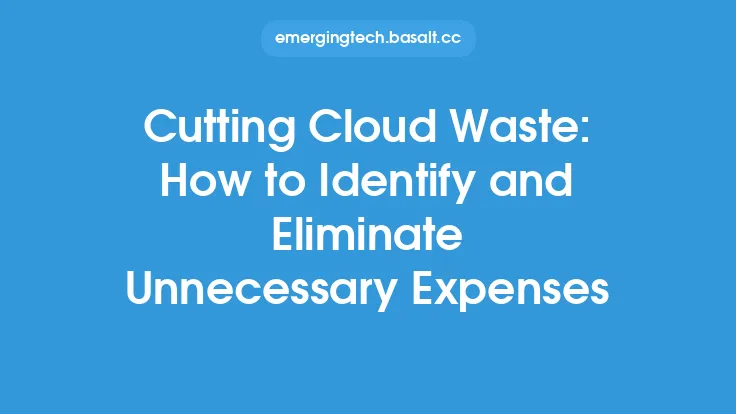Cloud computing has revolutionized the way businesses operate, offering unparalleled scalability, flexibility, and cost savings. However, as organizations increasingly migrate their workloads to the cloud, they often struggle to understand and manage their cloud costs. Cloud cost drivers are the underlying factors that influence an organization's cloud expenditure, and understanding these drivers is crucial to controlling and optimizing cloud costs.
Introduction to Cloud Cost Drivers
Cloud cost drivers can be broadly categorized into several key areas, including compute resources, storage, networking, and software licensing. Compute resources, such as virtual machines and containers, are a significant cost driver, as they are often the most resource-intensive components of a cloud deployment. Storage costs, including data storage and data transfer, can also add up quickly, especially for organizations with large amounts of data. Networking costs, such as data transfer and bandwidth, can be significant, particularly for organizations with global operations. Software licensing costs, including operating system and application licenses, can also be a substantial cost driver.
Compute Resources as a Cost Driver
Compute resources are a major cost driver in cloud computing, as they are often the most resource-intensive components of a cloud deployment. Compute resources include virtual machines, containers, and serverless computing, each with its own pricing model and cost implications. Virtual machines, for example, are priced based on the number of vCPUs, memory, and storage allocated, as well as the operating system and region. Containers, on the other hand, are priced based on the number of container instances and the resources allocated to each instance. Serverless computing, which allows organizations to run code without provisioning or managing servers, is priced based on the number of requests and the compute resources consumed.
Storage as a Cost Driver
Storage is another significant cost driver in cloud computing, as organizations often require large amounts of storage to support their applications and workloads. Cloud storage options, such as object storage, block storage, and file storage, each have their own pricing model and cost implications. Object storage, for example, is priced based on the amount of data stored and the number of requests made to the storage bucket. Block storage, on the other hand, is priced based on the amount of storage allocated and the number of IOPS (input/output operations per second) consumed. File storage, which provides a hierarchical storage system, is priced based on the amount of storage allocated and the number of files stored.
Networking as a Cost Driver
Networking is a critical component of cloud computing, as it enables communication between resources and applications. Networking costs, including data transfer and bandwidth, can be significant, particularly for organizations with global operations. Data transfer costs, for example, are incurred when data is transferred between regions or out of the cloud. Bandwidth costs, on the other hand, are incurred when data is transferred between resources or applications within the cloud. Organizations can minimize networking costs by optimizing their network architecture, using content delivery networks (CDNs), and leveraging cloud provider discounts.
Software Licensing as a Cost Driver
Software licensing is a significant cost driver in cloud computing, as organizations often require licenses for operating systems, applications, and other software components. Software licensing costs can be substantial, particularly for organizations with large-scale deployments. Organizations can minimize software licensing costs by leveraging open-source alternatives, using cloud provider licensing options, and optimizing their software usage.
Controlling Cloud Cost Drivers
Controlling cloud cost drivers requires a combination of technical, financial, and operational strategies. Organizations can start by monitoring their cloud usage and costs, using cloud provider tools and third-party solutions to track expenditure and identify areas for optimization. They can then optimize their resource utilization, using techniques such as right-sizing, reserved instances, and auto-scaling to minimize waste and reduce costs. Organizations can also leverage cloud provider discounts, such as committed use discounts and volume discounts, to reduce their costs. Finally, they can implement cloud cost governance frameworks, which provide a structured approach to cloud cost management and optimization.
Best Practices for Cloud Cost Optimization
Best practices for cloud cost optimization include monitoring and tracking cloud usage and costs, optimizing resource utilization, leveraging cloud provider discounts, and implementing cloud cost governance frameworks. Organizations should also establish clear cloud cost policies and procedures, provide training and awareness programs for cloud users, and continuously monitor and optimize their cloud costs. By following these best practices, organizations can effectively control their cloud cost drivers and optimize their cloud costs, achieving significant cost savings and improved ROI.
Conclusion
Cloud cost drivers are the underlying factors that influence an organization's cloud expenditure, and understanding these drivers is crucial to controlling and optimizing cloud costs. By understanding the key cost drivers, including compute resources, storage, networking, and software licensing, organizations can develop effective strategies to minimize their cloud costs. By leveraging technical, financial, and operational strategies, organizations can optimize their cloud costs, achieve significant cost savings, and improve their ROI. As cloud computing continues to evolve and mature, understanding and controlling cloud cost drivers will become increasingly important for organizations seeking to maximize the benefits of cloud computing while minimizing its costs.





